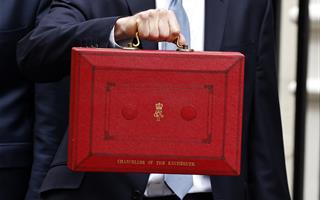A CFG survey conducted one year on from the announcement of a rise in Employer National Insurance Contributions finds that many charities are struggling with their finances.

"In my 25 years in the sector the outlook has never been so challenging for social care - it is as if the government are trying to break an already broken care sector."
This stark assessment from one charity leader captures the mood across the sector one year after the rise in Employer National Insurance Contributions (ERNICs). CFG's new survey reveals that 77% of those who responded to the survey reported a worse financial position than a year ago, 62% are running deficits, and organisations are being forced to make difficult choices between maintaining services and keeping staff. With multiple pressures hitting simultaneously, the data paints a bleak picture for the sector at large.
How did we get here?
CFG's survey, launched in October 2025, comes off the back of two previous surveys which sought to understand the level of concerns charities had following the last autumn budget in October 2024, where Rachel Reeves announced a 1.5% rise in Employer National Insurance Contributions. The initial surveys revealed deep concerns about the sector's ability to absorb these costs, with many members telling us they had reduced or planned to reduce headcount, or had cancelled plans for new staff or services.
This time, CFG surveyed 54 charity leaders, from CFG member charities and beyond, with respondents representing a wide variety of organisations. Over a quarter of respondents were from charities that employed less than 25 people, whilst another 26% were from ‘super-major’ organisations with annual incomes over £10m.
Likewise, the survey also received responses from a range of sectors. 3 in 10 respondents were from health or social care charities, whilst arts/culture (19%), education (11%) environmental (11%) and religious (6%) charities were also well represented in the data.

A deteriorating financial position
The survey found that the financial health of many charities has declined markedly over the past year. More than half of respondents (56%) to our survey report their finances are slightly worse than in October 2024, while a further 21% say they are significantly worse. Only 10% have seen any improvement, and not a single organisation in our survey reported significant improvement in their overall financial position.
Half of all respondents recorded a deficit in 2024/25 for at least the second year running, while 12% faced deficit for the first time. Even among the 37% maintaining a surplus, several noted this was only achieved through unsustainable measures such as selling property assets or receiving one-off endowments that masked underlying deficits.
One respondent remarked: "In 2024/25 we received an endowment which skewed our position to make it more favourable than it was. Without the endowment we would have been in significant deficit. This deficit is forecast to worsen in 2025/26 and is not sustainable."
The ERNICS impact
The rise in ERNICs has emerged as a major cost driver, with 46% of charities saying this was causing ‘a major impact’. More than one third of respondents said this impact was ‘moderate’. This compares to 31% who said that general inflation was having ‘a major impact’ on their charity’s finances, with 58% reporting the impact of inflation being ‘moderate’.
Charities said they were also struggling with the triple whammy of high inflation (96%), increased energy costs (49%) and the rise in the National Living Wage (59%). These pressures are hitting simultaneously, causing unprecedented financial strain which, in some cases, is insurmountable.
Difficult choices: staffing decisions
The human cost of these financial pressures is evident in the workforce decisions charities have been forced to make. Over half (51%) have not filled vacant positions, while 35% have made staff redundant, and a further 35% have cancelled plans for new hires. More than one in five (22%) have frozen or reduced salaries. And even for those who have not yet taken these specific actions, they have still been forced into difficult choices.
"While we haven't reduced or frozen salaries, we have implemented a lower cost of living increase (below inflation) than we normally would, so salaries have reduced in real terms," explained one respondent.
Another noted: "Staff were given a pay rise but a smaller one than would otherwise have been the case and barely in line with inflation."

Only 39% of our respondents have avoided taking any staffing actions, though several of these warned they were considering measures in the coming year. The constraints are particularly acute for care providers: "We are not able to make staff redundant because we are a care and support provider. Our central teams are very lean," one explained, while another added: "We can't reduce staff as we need certain staff ratios to provide safe care."
One respondent explained how the rise in ERNICs fits into the broader context: "The redundancy and the ‘not filled’ can't specifically be tied just to the rise in ERNICs but the overall financial outlook... obviously had (the rise in ERNICs) not happened the actions we would have taken may have been different."
The impact extends beyond immediate cuts. Charities report postponing building maintenance (24%), reducing travel budgets (28%), and cutting IT spending (18%) to manage costs. "Only carrying out essential H&S or compliance works to our care homes," one organisation explained.
Another reduced their death-in-service benefit from three times salary to 1.5 times salary, while one changed from death-in-service coverage to "a health cash plan" to reduce costs.
Service reductions and the impact on beneficiaries
The impact on beneficiaries cannot be underestimated. More than a fifth of the respondents have reduced or closed services, while 25% have cancelled plans for new services. Among those who haven't yet taken such measures, the warnings are ominous: "Not yet – but currently considering options," said one respondent. Others echoed: "But we are considering it in 2025/26" and "Not yet but we are planning to do so in 2026."
The human cost of these cuts could be stark, as when charities reduce or cease services, vulnerable people including those experiencing homelessness, mental health crises, domestic abuse or food insecurity may be left without vital support. As noted in Wave 9 of the VCSE barometer survey: "these changes are likely to hit communities hardest, particularly those that rely on voluntary organisations for support."

Many of these individuals rely heavily on charities, as they often provide interventions that statutory services cannot or will not deliver. In 2020/21, charities delivered £16.8bn worth of public services, highlighting the scale of their role in the support landscape.
This is also suggests a potential false economy, where the unintended consequences of the ERNICs rise outweigh short-term savings. When early intervention and preventative services are reduced, there is a risk that people's situations may deteriorate, possibly leading to increased demand on already stretched crisis services, NHS provision, and emergency public services. And with CAF’s latest research revealing demand for charities services continues to grow, the sector’s capacity to respond could be shrinking.
Seeking solutions in a difficult environment
Faced with these pressures, 60% of charities have sought new funding sources. However, the responses reveal the limitations of this approach.
"Sought it, but not necessarily got it. NHS commissioners have their hands tied so a larger proportion of services is being funded by the charity," one respondent explained.
Another, trying to increase major donor giving and legacies, noted it was "proving difficult and there’s a long time delay [to realising the benefits]."
The structural challenges are significant. One organisation stated that "there are limited options to diversify our income”, noting that they were initially expecting to see some improvement as a result of a national review of their parent organisation’s finances.
However, they added that: “Whilst this has led to some improvement, this is short term and falls short of the amount needed". Others highlighted their constrained position: "We have asked for higher fee increases from LAs (local authorities) with limited success."
Some organisations have resorted to extraordinary measures, with one charity applying for a loan “for the first time ever." Price increases for admissions offer limited relief for some, with one warning: "We have tried to absorb some costs, but have also raised more income through increased admission prices. This can't keep on being repeated, so cost cutting is likely to be needed if conditions don't improve."

A worsening outlook
Looking ahead, the picture remains bleak. Nearly two-thirds of charities (63%) anticipate needing further cost-reduction measures in the next six to 12 months. Just one fifth believe they probably or definitely won't need to take additional action.
The financial outlook for the next six to 12 months shows 44% expect conditions to somewhat worsen and 8% expect significant worsening. Only 12% anticipate any improvement, with 37% expecting their outlook to ‘stay roughly the same’.
"I think the funding gap is going to get bigger, and we will be facing significant cost pressures and need to use reserves to fund increases in minimum wages and NIC," one respondent warned.
Another noted: "Cash flow is going to be of increasing importance in decision making."
Additional pressures loom on the horizon. "The new SORP will also have a negative impact as more income will be deferred," one charity explained.
Another faces an additional £700,000 burden: "The Group VAT Structure notice from HMRC will add further financial pressure - increasing our costs by approximately £700k on top of the increases detailed above."
Despite these challenges, most organisations retain some confidence in their long-term viability, with 85% somewhat to extremely confident about remaining a going concern over five years. However, 15% are not confident, signaling genuine concerns about survival for a significant minority.
The sector responds: calls for support and mounting frustration
When asked what would be most helpful, charities' priorities were clear: 73% called for government relief packages for the ERNICS increase, 67% wanted increased grant funding from trusts and foundations, and 48% sought sector-wide advocacy for policy changes.
The sector's frustration with government policy was palpable. "As one charity leader expressed: "very disappointed that the House of Lords supported a charity exemption to the rises, but this was rejected. If we can't reduce our overheads, we will have to cut charitable activities, which will mean third sector shrinkage and more reliance on local authorities who have no capacity."

The sense of being caught in an impossible position is clear.
"I think the future is bleak for charities at the moment, we are already stretched and lean, and further cost pressures will magnify the problems," one charity leader wrote.
For those dependent on other organisations also affected by the rises, the impact compounds: "Our income is predominantly from parish churches and some of them will also have experienced the increase in NI impacting where they employ staff locally."
Facing a perfect storm
One year after the ERNICS rise, charities face a perfect storm of increased employment costs, persistent inflation, and largely static income. The result is a sector making painful choices about staffing, services, and sustainability. Without relief or increased funding, many organisations warn they will be forced to shrink activities precisely when demand for their services remains high or increases, shifting more burden onto already stretched local authorities and communities.
Charities exist to solve problems and meet the needs of our communities, though delivering this vital work depends on financial sustainability. Without the ability to meet their financial obligations, charities simply cannot continue the services and support that so many rely upon. The finding from this survey suggests that the increased operational costs of charities are fundamentally underminding charities’ capacity to fulfil their missions. As the sector continues to navigate these pressures, it is the people and communities who depend most heavily on charitable support – often the most vulnerable in our society – who stand to feel the greatest impact.
CFG are here for you
We know how vital it is to be part of a wider community of supportive finance professionals and charity leaders. Our member groups and helplines provide technical advice and insights, peer support and a safe space to ask questions and share experiences. We are here to help!
If you'd like to find out more about these, or any of our other membership benefits, please get in touch. We want to support you, your team and your organisation and we value your feedback and suggestions too.
Background to the survey
In October 2024, Rachel Reeves announced a 1.5% rise in Employer National Insurance Contributions (ERNICs). At the time, CFG highlighted our members’ views, captured through a survey which revealed deep concerns about the sector’s ability to absorb these increased costs. Additionally, NCVO estimated that the rise would cost £1.4bn for charities overall and, along with ACEVO, launched an open letter signed by over 7,000 organisations across the sector. And following this, politicians cited CFG’s findings in parliamentary debates, and there was much media coverage of the impact of the ERNICs’ rise on charities.
In March 2025, our members responded to a second survey asking them about their levels of concern, as well as whether they had taken any actions to cope with the impact of the rise. Over two thirds said their charity had already started to reduce headcount, or would in the near term, whilst 41% said that they had already cancelled plans to take on new staff or launch new services that would otherwise have gone ahead, with a further 23% saying that they are likely to do so in the near future.
The rise in ERNICs came into effect on 1 April 2025, and CFG has now conducted a third survey to ask members about their charities’ current financial position compared to one year ago, any specific actions they have now taken as a result, and what the outlook is for future years. This survey featured 54 respondents from a range of charity sizes and sectors.